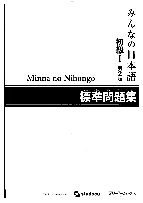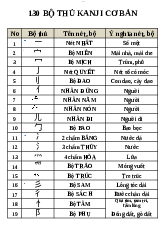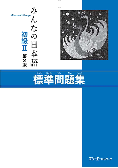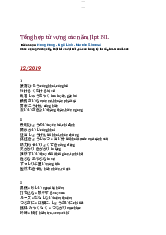



















Preview text:
lOMoARcPSD|46958826 lOMoARcPSD|46958826 lOMoARcPSD|46958826
FIRST STEPS TO MASTERING THE JAPANESE WRITING SYSTEM Japanese HIRAGANA KATAKANA for Beginners
The method that’s helped thousands in
the U.S. and Japan learn Japanese successfully Timothy G. Stout Il ustrated by Alexis Cowan T UT T L E Publishing Tokyo Rutland, Vermont Singapore lOMoARcPSD|46958826
The Tuttle Story: “Books to Span the East and West”
Most people are surprised to learn that the world’s largest publisher of books on Asia had its
humble beginnings in the tiny American state of Vermont. The company’s founder, Charles E.
Tuttle, belonged to a New England family steeped in publishing. And his first love was naturally
books—especially old and rare editions.
Immediately after WW II, serving in Tokyo under General Douglas MacArthur, Tuttle was tasked
with reviving the Japanese publishing industry. He later founded the Charles E. Tuttle Publishing
Company, which thrives today as one of the world’s leading independent publishers.
Though a westerner, Tuttle was hugely instrumental in bringing a knowledge of Japan and Asia
to a world hungry for information about the East. By the time of his death in 1993, Tuttle had
published over 6,000 books on Asian culture, history and art—a
legacy honored by the Japanese emperor with the “Order of the
Sacred Treasure,” the highest tribute Japan can bestow upon a non-Japanese.
With a backlist of 1,500 titles, Tuttle Publishing is more active
today than at any time in its past—inspired by Charles Tuttle’s
core mission to publish fine books to span the East and West
and provide a greater understanding of each.
Published by Tuttle Publishing, an imprint of Periplus Editions (Hong Kong) Ltd.
www.tuttlepublishing.com
Copyright © 2011 by Periplus Editions (Hong Kong) Ltd.
All rights reserved. No part of this publication may be reproduced or utilized in any form or by any
means, electronic or mechanical, including photocopying, recording, or by any information storage
and retrieval system, without prior written permission from the publisher.
ISBN: 978-1-4629-0101-2 (EBOOK) Distributed by
North America, Latin America & Europe Tuttle Publishing 0
Innovation Drive, North Clarendon, VT 05759-9436 U.S.A.
Tel: 1 (802) 773-8930; Fax: 1 (802) 773-6993
info@tuttlepublishing.com www.tuttlepublishing.com Japan Tuttle Publishing
Yaekari Building, 3rd Floor, 5-4-12 Osaki, Shinagawa-ku, Tokyo 141 0032
Tel: (81) 3 5437-0171; Fax: (81) 3 5437-0755 sales@tuttle.co.jp www.tuttle.co.jp Asia Pacific Berkeley Books Pte. Ltd.
0 Tai Seng Avenue #02-12, Singapore 534167
Tel: (65) 6280-1330; Fax: (65) 6280-6290
inquiries@periplus.com.sg www.periplus.com 1615141312 109876543 1205MP Printed in Singapore
TUTTLE PUBLISHING® is a registered trademark of Tuttle Publishing, a division of Periplus Editions (HK) Ltd. lOMoARcPSD|46958826 CONTENTS
Introduction...........................................................................................................................5 — HIRAGANA — SECTION ONE
The Basic 46 Hiragana Characters.....................................................................................13
Reading Practice 1: あ ~ そ..............................................................................................29
Reading Practice 2: た ~ ほ..............................................................................................45
Reading Practice 3: ま ~ ん..............................................................................................62 SECTION TWO
Hiragana Usage Rules.........................................................................................................63
Rule 1: Tenten and Maru......................................................................................................64
Reading Practice 4: Tenten and Maru..................................................................................71
Rule 2: Combined Characters...............................................................................................71
Reading Practice 5: Combined Characters...........................................................................77
Rule 3: Small “tsu”..............................................................................................................78
Reading Practice 6: Small “tsu”..........................................................................................79
Rule 4: Long Vowels...........................................................................................................79
Reading Practice 7: Long Vowels........................................................................................80
Rule 5: Sentence Particles “wa,” “e” and “o”........................................................................81
Reading Practice 8: Particles “wa,” “e” and “o”...................................................................83 SECTION THREE
Reading and Writing Practice............................................................................................84
Answers...............................................................................................................................99 lOMoARcPSD|46958826 — KATAKANA — SECTION FOUR
The Basic 46 Katakana Characters..................................................................................100
Reading Practice 1: ア ~ ソ.............................................................................................116
Reading Practice 2: タ ~ ホ.............................................................................................132
Reading Practice 3: マ ~ ン.............................................................................................149 SECTION FIVE
Katakana Usage Rules......................................................................................................150
Rule 1: Tenten and Maru....................................................................................................150
Reading Practice 4: Tenten and Maru................................................................................156
Rule 2: Combined Characters.............................................................................................157
Reading Practice 5: Combined Characters.........................................................................163
Rule 3: Small “tsu”............................................................................................................163
Reading Practice 6: Small “tsu”........................................................................................165
Rule 4: Additional Combined Characters............................................................................165
Reading Practice 7: Additional Combined Characters........................................................172 SECTION SIX
Reading and Writing Practice..........................................................................................173
Answers.............................................................................................................................187
Flash Card Practice Activities..........................................................................................191
Acknowledgments.............................................................................................................192 Ỵ lOMoARcPSD|46958826
HOW TO DOWNLOAD THE BONUS MATERIAL OF THIS BOOK.
0 You must have an internet connection.
1 Click the link below or copy paste the URL to your web browser.
http://www.tuttlepublishing.com/japanese-hiragana-katakana-for-
beginners-downloadable-cd-content
For support email us at info@tuttlepublishing.com. lOMoARcPSD|46958826 5 Introduction
You probably picked up this book because you are interested in the best way to learn hira-
gana and katakana. If so, you came to the right place. The methods in this book have
helped thousands of students in the United States and Japan to successfully learn both, and they can help you too.
This book makes learning hiragana and katakana fast and effective by using clear expla-
nations and examples and lots of fun exercises. It also features memorable picture
mnemonics like the one below. Picture mnemonics enhance memory by associating the
shape and sound of each character with pictures and English words already familiar to you.
For example, the hiragana character “mo” as in “more” looks like a fishhook intersected by
two lines, leading to the idea that “you can catch more fish with more bait.”
“mo” as in “more” You can catch more fish with more bait.
Katakana and hiragana characters—together called kana—are the two sets of 46 pho-
netic characters used in Japanese. An average, diligent student can learn to read the basic
46 hiragana and 46 katakana characters in a few hours, and with persistence can learn to
write them in a few days. If you study for thirty minutes a day, in a few short weeks you will
be a confident reader and writer of hiragana and katakana. How to Use This Book
This introduction gives you basic information about the characters: where they came from,
how to pronounce and write them, and even how to write your name.
Both hiragana and katakana are essential to basic Japanese proficiency, but normally
hiragana is learned first. In Section One you will learn the basic 46 hiragana characters, and
how to write some simple words. Section Two introduces the usage rules that will allow you
to write all of the sounds of Japanese and gives you more opportunities for practice. Section
Three strengthens your hiragana skills through a wide range of exercises designed to both
increase your knowledge of the Japanese language and reinforce your newly acquired writ-
ing skills. Then in Sections Four, Five and Six you will follow the very same process to
master the katakana characters.
At the end of the book you will find a list of suggested flash card activities. Since it is
easier to learn to recognize hiragana and katakana than to write them, you may want to
begin with the flash cards, printing them from the CD-ROM and reviewing them often. As
you learn to recognize the characters, you will find it much easier to write them. Whether
you begin with the writing sections or the flash cards, you will get the most out of this book by doing all the activities. lOMoARcPSD|46958826 0 INTRODUCTION
An Overview of the Japanese Writing System
Japanese uses four types of scripts: hiragana, katakana, kanji and romaji. 5888
Hiragana is a cursive set of 46 phonetic characters that express all of the sounds of
Japanese. Hiragana is used mainly for writing the grammatical parts of sentences and
native Japanese words for which there are no kanji. 5889
Katakana is an angular set of 46 phonetic characters, generally used for writing
foreign words and for showing emphasis. 5890
Kanji are characters of ancient Chinese origin that represent ideas and sounds,
and they are used for most nouns, verbs and other “content” words. There are 2,131
“common use” kanji that school children must learn by ninth grade. 5891
Romaji are roman (Latin) letters used to write Japanese; you must already know
romaji since you are reading this. Romaji is used in textbooks and dictionaries for
foreigners learning Japanese (and for Japanese people learning western languages) but
its use in day-to-day writing is somewhat limited to things like company names and acronyms. ọỤầễ ỽἑỽἜ Romaji Hiragana Katakana Kanji
Don’t be too intimidated by the number and seeming complexity of Japanese characters.
Japan’s 99 percent literacy rate should allay any fears that learning Japanese is impossible.
Compared to kanji, kana characters are not complex; each one only has between one and
four strokes. Each set of kana has 46 characters, compared to the English alphabet which
has 52 letters (26 upper case and 26 lower case). Although kana characters have a few
more overall strokes than the letters of the alphabet, kana have a consistent one-to-one
relationship between character and sound. By contrast more than half of the English
alphabet letters have multiple pronunciations, and seemingly endless exceptions. Anyone
who has learned the complexities of English spelling can succeed at learning kana. So,
although learning hiragana and katakana may at first seem to be a Sumo-sized task, with
the right training and practice you can do it! Before you know it you’ll be a kana champion!
Don’t rely on romaji. Foreigners learning Japanese sometimes rely on romaji, never
learn-ing to read and write. While it is possible to become quite proficient in speaking
Japanese using only romaji, you will not be truly literate. Get comfortable using hiragana.
When you buy a dictionary make sure it is written in hiragana, not romaji. When you write in
Japanese use hiragana and katakana and kanji characters as you learn them. lOMoARcPSD|46958826 INTRODUCTION 7
How to Pronounce Hiragana and Katakana
Hiragana and katakana are pronounced the same way. The first five characters are the five
Japanese vowels. Japanese vowels are short and clipped compared to English vowels. (All
of the examples in this book use Standard American English pronunciation). 23 as in father 5888 as in easy uas in you 23 as in red 5888 as in oak
The rest of the characters are consonant-vowel combinations, with the consonant
always coming first (e.g., “ka,” “ki,” “ku,” “ke” and “ko”). The one exception is the single
consonant syllable “n” that is pronounced by touching the back of the tongue to the roof of
the mouth, as in “ink” and “sing.” Many Japanese consonants are commonly found in
English and are easy to pronounce. k as in coat g
as in goat (voiced version of k) s as in Sue z
as in zoo (voiced version of g) t as in tie d
as in dye (voiced version of t) 23 as in no 5888 as in house p as in pig b
as in big (voiced version of p) 23 as in man
Several Japanese consonants, however, are not commonly found in English and require
special attention. One is the Japanese “r.” In English “r” is pronounced by curling the tongue
so the sides touch the upper teeth (not touching the tip of the tongue). In Japanese, “r” is
pronounced by tapping the tongue against the ridge behind the upper teeth, as in “paddle”
and “ladder,” sounding like a combination of “l” and “d”; it is not a rolling trill as in Spanish.
“tsu” is pronounced as in “tsunami” and “cat’s whiskers.” “fu” is pronounced without touching
the upper teeth and lower lip. It almost sounds like “who” and “hooting owl,” except the lips
are more pursed and air escapes more quickly.
The special consonant “y” as in “yarn” is paired with the vowels “a,” “u” and “o” to make
the syllables “ya,” “yu” and “yo.” This consonant is special because Japanese uses it
extensively in combination with all of the other consonants to form additional syllables, such
as “kya,” “kyu” and “kyo.” In order to accommodate more foreign syllables, many more
character combinations are used in katakana (see Section Five).
Although katakana tries to represent gairaigo (“loan words”) as faithfully as possible, the
words sound distinctly Japanese. In 1991 the Japanese government updated the official
guidelines for writing gairaigo. The guidelines included 33 more combined characters for
writing foreign words. These 33 combined characters are not the limit—the guidelines
clearly state that other combinations can be made as needed. Still, all syllables must
conform to the basics of Japanese phonology (see Section Two). lOMoARcPSD|46958826 23 INTRODUCTION How to Write Hiragana
Hiragana is the first writing system that Japanese children learn. It is not uncommon for a
four-year-old to be able to fluently read children’s books and the like because of hiragana’s
simple one-to-one correspondence between characters and sounds. Hiragana can easily be
used to write any word or phrase, and even adults will sometimes substitute hiragana for
difficult or uncommon kanji characters.
According to the U.S. Foreign Service Institute, it takes approximately 1,300 hours to
acquire advanced Japanese proficiency, but much less time is required for basic proficiency.
Hiragana is a great place to begin. The immediate benefits of learning hiragana include
improving your pronunciation and gaining access to hundreds of dictionaries, textbooks, and
other learning and enrichment materials written with hiragana. Plus, all of the writing skills of
hiragana are transferable to learning katakana and kanji, making them easier to learn.
There are various styles used to write hiragana, but this book only uses the most stan- -
dard kyo kashotai or “schoolbook” style. Hiragana characters are composed of three types
of strokes: “stops,” “jumps” and “brushes.” With a stop, the pencil must come to a stop
before it is removed from the paper. Jumps are written by removing the pencil from the
paper as it moves to the next stroke. With a brush, the pencil is slowly removed from the
paper as the stroke is written, giving it a tapered, sweeping appearance. In the example
below, the char-acter “ke” as in “Kevin” is written with all three types of strokes. The first
stroke is a jump, the second is a stop, and the third is a brush. 1 3 2
Writing the correct stroke types in the correct order is important for forming balanced,
legible characters. With practice you will get the hang of it. You can make your characters
look more authentic by slightly tilting left-to-right strokes, as in stroke two in “ke” (see above),
rather than writing them straight across. Character strokes are generally written from left to
right and top to bottom. Try to center each character in an imaginary box, not too far to the left, right, top or bottom. ᴾẬ Ậ Ậ Ậ Ậ Correct! Wrong Wrong Wrong Wrong
Traditionally Japanese was written from top to bottom, progressing in columns from right
to left across the page. Now it is also commonly written from left to write, as with English. All
the hiragana in this book is written from left to right. lOMoARcPSD|46958826 INTRODUCTION 9 How to Write Katakana
Katakana characters also are composed of the same three types of strokes we discussed
above: “stops,” “jumps” and “brushes.” In the following example, the character “o” as in “oak”
is written with all three types of strokes. The first is a stop, the second a jump, and the third is a brush. 2 3
Compare the hiragana and katakana characters below. Hiragana characters are curved
and looping, but katakana characters are straight and angled. Katakana also has fewer
“jumps” and more “stops” and “brushes.” a i ka ki sa shi ta chi 0 Ầ ẟ ẨẰẲẺẼ ỴỶ ἇἉἑἓ ỽỿ
Some hiragana and katakana characters look alike, like “ka” and “ki.” The picture mne-
monics for these katakana characters are the same as the hiragana characters—another
good reason you should master hiragana first.
Writing the correct stroke type in the correct order is important for forming balanced,
legible characters. With practice you will get the hang of it. You can make your characters
look more authentic by slightly tilting left-to-right strokes, as in stroke one in “o” (see above),
rather than writing them straight across. Character strokes are generally written from left to
right and top to bottom. Try to center each character in the middle of an imaginary box, not
too far to the top, bottom, left, or right. Ỽ Ỽ Ỽ Ỽ Ỽ Correct! Wrong Wrong Wrong Wrong lOMoARcPSD|46958826 0 INTRODUCTION
Writing Your Name in Japanese
Most beginning learners enjoy katakana because it is relatively simple to learn, and it is
immediately useful. You write your name and your friends’ names in katakana. You can
guess many of the katakana words found in Japanese texts you read. Soon reading and
writ-ing katakana will become second nature, and all your hard work will begin to pay off.
Try to find your name in the “Names in Katakana” lists provided on the CD-ROM. Only
one Japanese spelling is given for all of the names with the same pronunciation, such as
Amy, Ami, Amie and Aimee. The names are listed under the most common spelling. If you
don’t see your name in the list and your name is a nickname, try looking for the formal
version (i.e., “Richard” instead of “Rick”). If you still can’t find your name, it may not be one
of the most common. Never fear, you can ask your teacher or a Japanese friend for help.
Any name can be written in Japanese. Practice writing your name in the spaces provided
(don’t worry if you leave some boxes unused).
Where Hiragana and Katakana Came From
Although hiragana characters look like the picture mnemonics in this book, they did not
originally come from pictures. Hiragana characters were developed based on simplified
cursive-style kanji during the Heian Period (794-1185 AD). China, one of the great
civilizations of the ancient world, had a huge influence on its Asian neighbors, including
Japan. Kanji were first introduced to Japan around the 5th century AD.
The Japanese upper classes made a serious study of Chinese language, religion and gov-
ernment, and along with adopting new perspectives and practices, they adopted thousands of
words and the kanji used to write them. The earliest official documents were written in Chinese,
and for a long time Chinese was considered the language of the educated. Japanese also used
kanji, however, to write poetry and prose in Japanese. This was problematic since spoken
Japanese and Chinese were very different, but the Japanese overcame this chal enge by giving
kanji new Japanese pronunciations, and by using some kanji as phonetic charac-ters to be able to
express native Japanese words and grammatical elements in writing.
Kanji used as phonetic characters were called kana or “borrowed names,” implying that
using kanji to express only sounds was not the regular practice. The first set of kana, called –
man’yogana (the line above the “o” indicates it is two syllables in length), was difficult to
read because there were no one-to-one relationships between the characters and sounds, plus –
there were hundreds of them. Man’yogana was also difficult to write because each phonetic
syllable had to be written in kanji. To simplify things, two sets of kana called katakana and
hiragana were developed over time. Katakana or “partial kana” as the name suggests was
developed from parts of kanji (see the following example). lOMoARcPSD|46958826 INTRODUCTION 11 Ỵ ẝ – – “a” in man’yogana “a” in man’yogana “a” in katagana “a” in hiragana (one of many) (one of many)
Writing with katakana was originally limited to men, and used in official documents.
Hiragana or “common kana” was developed based on simplified versions of entire kanji
characters (see example above). It was used in informal writing, such as letters and diaries,
and it was referred to as onna-de or “woman’s hand.”
Ironically, during the Heian period while the men were attempting to write in “supe-rior”
Chinese, some women who learned to write in hiragana produced the finest literature of the
period. The Tale of Genji written 1,000 years ago by a court lady named Murasaki Shikibu is
generally regarded as the world’s first novel, and a classic. In time, men began using
hiragana as well. Today Japanese is written with a mix of hiragana, katakana, kanji and romaji.
The Tale of Genji by Murasaki Shikibu
is over 1,000 pages in English translation.
History aside, you may be wondering why Japanese still has two sets of phonetic char-
acters. The main reason is that it makes reading easier—katakana words stand out in a text,
like a highlighter. When you see a katakana word, you immediately know it falls into one of six categories:
0 Gairaigo or “loan words”
1 Foreign place names and personal names
2 Onomatopoeia (sound symbolic words), like “buzz,” “flip” and “bow wow,” which are
much more numerous in Japanese than in English
3 Emphasis words—normally written in hiragana or kanji, but that the writer wants to draw attention to
4 Dictionaries entries of on-yomi or the “Chinese readings” of kanji lOMoARcPSD|46958826 INTRODUCTION
Others, such as transcriptions of the Ainu language (indigenous to northern Japan), and
some official documents of pre-modern Japan – – –
Gairaigo or “loan words,” such as konpyuta (computer), nyusu (news), and resutoran
(restaurant), comprise the biggest category of katakana words, with tens of thousands in
common use. Most gairaigo come from English, so even beginning learners can often cor-
rectly guess what a Japanese article is about just from scanning the text for gairaigo. Topics
like sports, medicine, business, economy, technology, and science have numerous gairaigo.
Japanese Hiragana and Katakana for Beginners is the right place to begin your
Japanese stud-ies. As you learn kana you will be taking the first steps to mastering the
Japanese writing system and its pronunciation. Taking Japanese in small steps will make it
more manageable. As the Japanese proverb states, “Even dust piled up becomes a
mountain.” or in other words, little things add up! Ẽụờ ờủị ểễỦ
chiri mo tsumoreba yama to naru
(Even dust piled up becomes a mountain.)
Good luck as you embark on this new journey. As you increase your understanding of
the Japanese people and their wonderful culture and language you will find fresh
encourage-ment to carry on. One step at a time you can do anything. So, let’s get started.
Turn the page and begin your journey. lOMoARcPSD|46958826 SECTION ONE
The Basic 46 Hiragana Characters ẝ ẟ ạ ả ấ a i u e o Ầ Ẩ Ẫ Ậ Ắ ka ki ku ke ko Ằ Ẳ Ẵ Ặ Ẹ sa shi su se so Ẻ Ẽ ế ề ể ta chi tsu te to ễ Ệ ệ Ỉ ỉ na ni nu ne no Ị ọ Ố ồ Ỗ ha (wa)* hi fu he (e)* ho ộ Ớ ớ Ờ ờ ma mi mu me mo ở ỡ ợ ya yu yo Ụ ụ Ủ ủ Ứ ra ri ru re ro Ừ ử wa o** Ữ n
0 These characters are pronounced differently when they are used as grammatical particles. **
This character is only used as a grammatical particle. It is not used to write words. lOMoARcPSD|46958826 0 SECTION ONE
ẝ123“a” as in father “Open your mouth and say ‘Ah,’” says the dentist.
Writing Tip “a” has three strokes: 1) a stop, 2) stop and 3) brush. Trace these characters. ᴾ ᴾ ẝ ᴾ ẝ ᴾ ẝ ᴾ ẝ ᴾ ẝ ᴾ ẝ ᴾ ẝ ẝ
Write the character in the boxes below, and then circle the one you think is best. 1. a ka (red) 2. a ri (ant) 3. a sa (morning) Ầ ụ Ằ 4. a ki (autumn)
5. a me (rain; hard candy) 6. a o (blue) Ẩ Ờ ấ lOMoARcPSD|46958826
ẟ THE BASIC 46 HIRAGANA CHARACTERS15 H ẟ AWA 2 1
“i” as in easy
the two “i’s” in Hawaii
Writing Tip “i” has two strokes: 1) a jump and 2) stop. Trace these characters. ᴾ ᴾ ẟ ᴾ ẟ ᴾ ẟ ᴾ ẟ ᴾ ẟ ᴾ ẟ ᴾ ẟ ẟ
Write the character in the boxes below, and then circle the one you think is best. 1. i i (good) 2. i su (chair) 3. ha i (Yes!) ẴỊ
4. o i shi i (delicious) 5. i ka (squid) ấ Ẳ Ầ lOMoARcPSD|46958826 0 SECTION ONE ạ ạ 1 2
“u” as in youth
Ew! There’s a bug on your ear!
Writing Tip “u” has two strokes: 1) a stop and 2) brush. Trace these characters.
ᴾạᴾ ạᴾ ạᴾ ạᴾ ạᴾ ạᴾ ạᴾ ạ
Write the character in the boxes below, and then circle the one you think is best. 1. u chi (home) 2. u de (arm) 3. u e (up) Ẽ Ể ả 4. u shi (cow) 5. u ma (horse) 6. u me (plum) Ẳ ộ Ờ lOMoARcPSD|46958826
THE BASIC 46 HIRAGANA CHARACTERS 17 ả ả 1 2
“e” as in red
An elf is hanging ornaments on a Christmas tree.
Writing Tip “e” has two strokes: 1) a jump and 2) zigzag stop. Trace these characters.
ᴾảᴾảᴾảᴾảᴾảᴾảᴾảᴾả
Write the character in the boxes below, and then circle the one you think is best. 1. e ki (train station) 2. ma e (in front of)
3. e e (yes – colloquial) Ẩ ộ 4. e n (yen) 5. ha e (fly) 6. e bi (shrimp) ỮỊ Ỏ




